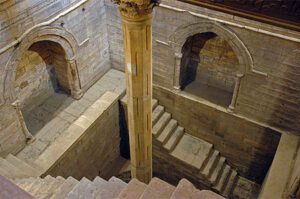The Nilometre
The Nilometre is situated on the Roda Island in a calm and charming place off the beaten tourist track, The Nilometre is the oldest Islamic monument in Cairo that has survived practically intact.
Until the construction of The High Dam at Aswan, Egyptian life was governed by the annual flooding of the Nile. Most years, its waters rose to swamp the river valley, and then retreated, leaving behind richly fertile deposits of alluvial soil.
Although there is evidence that a Nilometre has existed in this location since the Pharaonic Period, this one was built in 861 AD.
The Nilometre, like others built millennia before, was built to measure the rise and fall of the river, and thus predict the fortunes of the annual harvest. If the water rose to 16 cubits (a cubit is about the length of a forearm) (8.6m.-22 ft.) the harvest was likely to be good, inspiring one of the greatest celebrations of the medieval era. Any higher, however, the flooding could be disastrous, while lower levels predicted hunger.
Crop yields were predicted and taxes were set according to The Nile River’s level in August, as measured by a series of Nilometres from Aswan down The Valley to Roda and The Delta.
The Nilometer is a sophisticated instrument. It consists of a pit that extends well below the level of The Nile that in turn connects with The Nile through tunnels dug on three levels on The Nile’ Eastern side.
The measuring device, a graduated column, sits below the level of The Nile at the bottom of a flight of precipitous steps, which the guard will cheerfully let you descend.
Plain Kufic inscriptions adorn the walls of the Nilometre and are the earliest surviving examples of architectural epigraphy (inscriptions considered as a group) in Egypt. These inscriptions were executed in white marble originally on a blue background, though the letters themselves were left in the natural stone colour.
Also available to view here is The Museum of The Iconic Egyptian Singer Om Khalthoum
Om Kalthoum Museum. It is a must-see for anybody looking to learn about Middle Eastern Music. The museum is dedicated to the most famous singer in the Middle East and the Arab world. She is an iconic female singer who passed away in 1975 but her fame still flourishes today. The Museum is very well designed, furnished with her personal items, her music, and documentation about her life.


